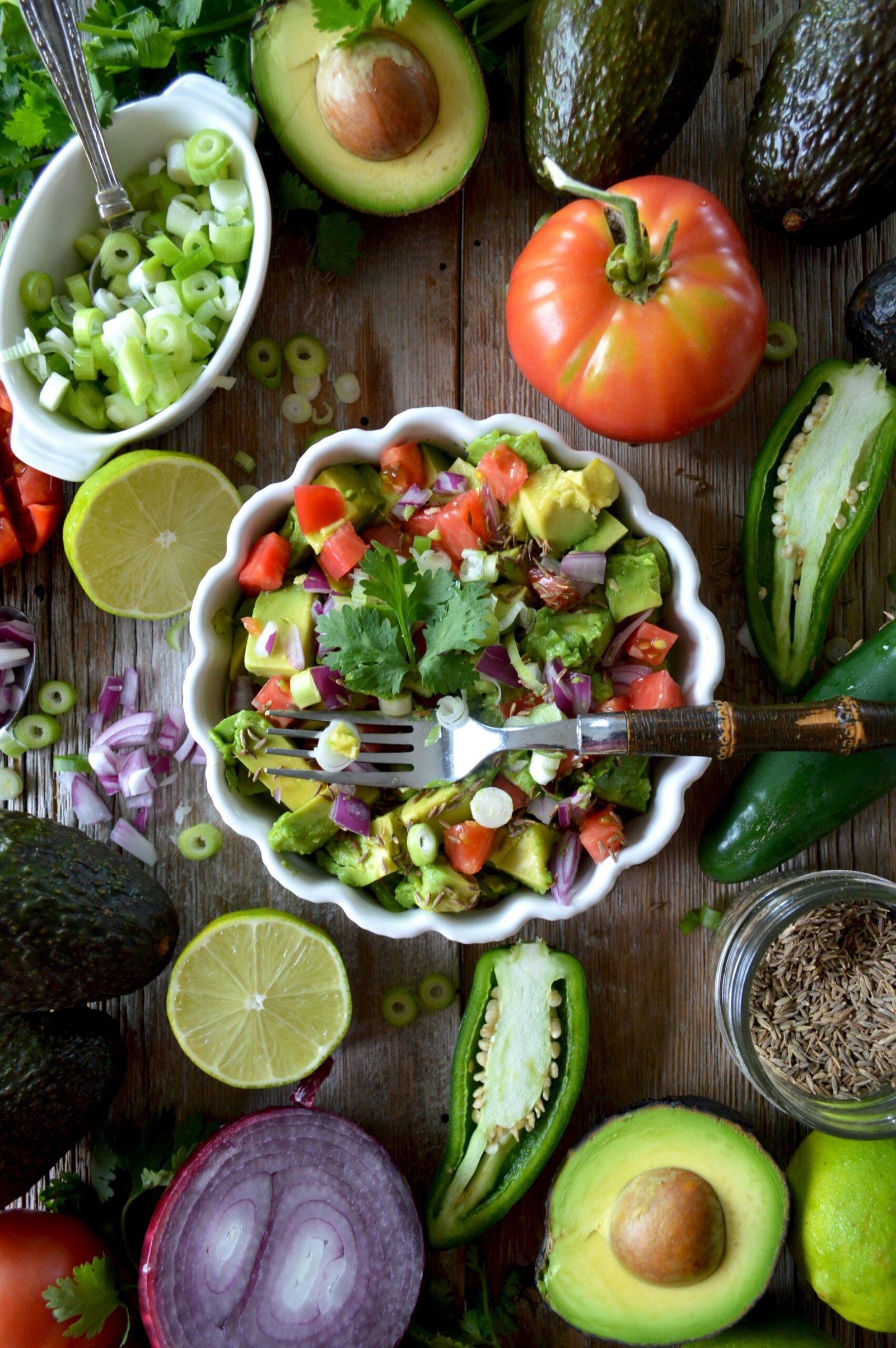
Gentle, Effective Low-Impact Workout Routines
Low-impact workout routines are great for people with joint problems or those healing from injuries. They offer a full-body workout without hurting the joints. This makes them perfect for everyone, no matter their fitness level1.
These exercises are easy on your joints, perfect for those with arthritis or recovering from injuries. You can find them on websites like low-impact workout routines. Examples include cycling, swimming, and walking, all of which are low-impact1.
Understanding the benefits of low-impact workout routines is key. They include low-impact exercises, gentle plans, and routines that are easy on the joints.
Key Takeaways
- Low-impact workout routines are gentle on joints, ideal for people with arthritis or recovering from injuries1.
- Examples of low-impact exercises include cycling, swimming, and walking, which are all low-impact workout routines1.
- Low-impact workout routines can provide a full-body workout without straining the joints, making them suitable for people of all fitness levels, including low-impact workout routines, gentle exercise plans, and joint-friendly fitness routines1.
- Research found that post-menopausal women with knee osteoarthritis experienced weight loss and improved walking speed after a four-month aquatic resistance training program1.
- Walking, when brisk, can significantly benefit balance, coordination, mood, weight management, as well as prevent or manage various health conditions such as heart disease, high blood pressure, and type 2 diabetes1.
- Indoor cycling may improve aerobic capacity, blood pressure, lipid profile, and body composition as per a 2019 study2.
Understanding Low-Impact Workouts
Low-impact workouts are gentle on your joints. They’re perfect for people with joint pain or those just starting out. These exercises are great for many, including those with joint issues, beginners, and athletes3. They offer a tough yet fun workout without putting too much strain on your joints4.
Examples of low-impact exercises include walking, yoga, Pilates, swimming, skating, cross-country skiing, and golf3. These activities are low-impact because they don’t harshly affect your joints and tendons. They avoid activities that are hard on your body, like jumping or heavy bounding5. Plus, they’re easier on your body, so you can work out more often5.
Adding activities like brisk walking, biking, dancing, gardening, swimming, and taking the stairs can benefit both seniors and younger folks3. Starting your day with 15 minutes of stretching can also help make low-impact exercise a part of your daily routine3. Low-impact workouts can be customized to fit your needs and goals. They’re a fantastic choice for those wanting a lasting and enjoyable way to stay active.
Types of Low-Impact Workouts
Low-impact workouts are gentle on the joints. They’re great for people recovering from injuries or dealing with chronic pain. You can choose from aerobic exercises, strength training, and exercises that improve flexibility and mobility. Walking and swimming are excellent low-impact cardio options that boost heart health without harming your joints6.
Strength training is key in low-impact workouts. You can make it easier by using lighter weights and doing more reps7. This helps build muscle and strengthen bones, lowering the risk of osteoporosis and fractures. You can do low-impact strength training with bodyweight exercises, resistance bands, or gym machines8.
Here are some examples of low-impact workouts:
- Yoga and Pilates for flexibility and core strength
- Cycling and swimming for cardio
- Rowing and elliptical machines for a full-body workout
These workouts can be adjusted to fit your fitness level and goals. Adding them to your routine can enhance your health and fitness without straining your joints6.
Popular Low-Impact Workout Routines
Low-impact workouts are great for keeping fit without harming your joints. They can be adjusted for all fitness levels. This makes them perfect for beginners or those recovering from injuries. Swimming and water aerobics are excellent for boosting heart health without the need for high-impact moves9.
Yoga and Pilates are also good choices. They enhance flexibility and balance while strengthening the core and other muscles. Cycling and brisk walking are also low-impact and can be done indoors or outdoors. They’re great for improving heart health10.
Some top low-impact routines include:
- Swimming and water aerobics
- Yoga and Pilates
- Cycling and brisk walking
These routines can be tailored to fit your fitness level and require little equipment. They’re perfect for those who want to stay active without stressing their joints11. Adding these routines to your fitness plan can greatly improve your health and well-being.
| Workout Routine | Duration | Intensity |
|---|---|---|
| Swimming and water aerobics | 30-60 minutes | Low-Moderate |
| Yoga and Pilates | 30-60 minutes | Low-Moderate |
| Cycling and brisk walking | 30-60 minutes | Moderate-High |
Designing Your Own Routine
Creating a personalized low-impact workout routine can be tough, but it’s doable. Start with beginner-friendly exercises that are easy on your joints. These can be adjusted to fit your fitness level12. You can mix in yoga, swimming, or cycling, all of which are gentle on your body13.
To start, check your current fitness level. You can do this by measuring your heart rate after walking a mile or by tracking your pushups and flexibility13. After knowing your level, set achievable goals and plan your workouts. Aim to exercise 2 to 4 times a week for 30 to 45 minutes, with a day off in between12.
Your routine should have a variety of exercises. Include compound exercises like squats, lunges, and deadlifts, which work many muscles at once. Start slow and increase your workout intensity by no more than 10% each week1213.
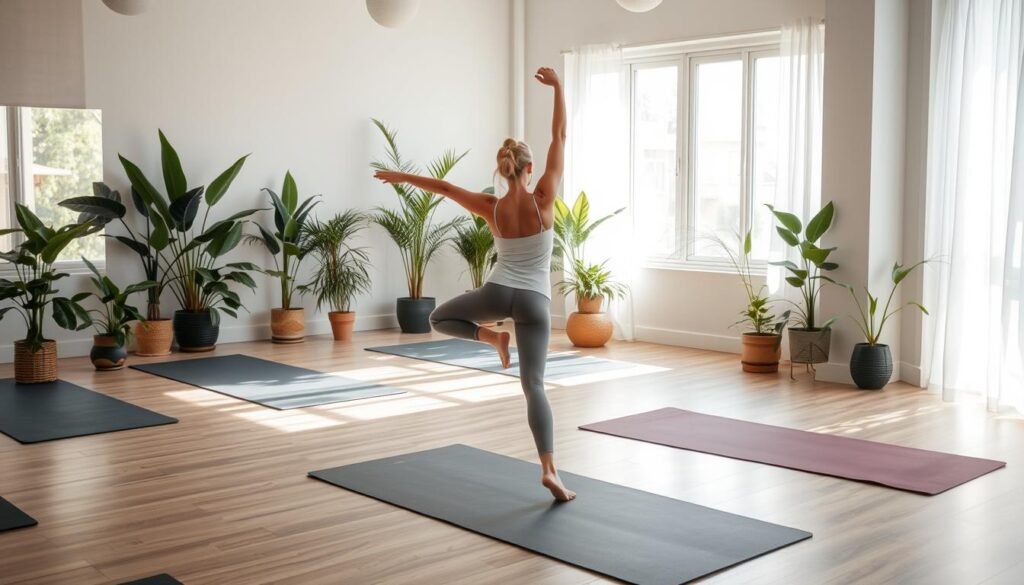
By following these steps and adding beginner-friendly exercises to your routine, you can make a workout plan that fits you. Stay consistent, listen to your body, and enjoy the process1213.
Warm-Up and Cool Down Techniques
When doing low-impact cardio like brisk walking or cycling, it’s key to use warm-up and cool-down methods. This helps avoid injuries and boosts performance14. A good warm-up, lasting 5 to 10 minutes, gets blood flowing to muscles. This makes them less sore and more flexible15.
For workouts with little impact, like bodyweight exercises, these steps are vital. They get the muscles ready for action.
Effective cool-downs, like static stretches, cut down muscle soreness and boost flexibility14. Holding stretches for 10 to 30 seconds, with the right breathing, makes the cool-down better14. Even low-impact strength training benefits from these techniques15.
By using these methods, people can lower injury risks and enhance their workout experience.
Some warm-up activities include:
- Light cardio, such as jogging in place or jumping jacks
- Dynamic stretches, such as leg swings or arm circles
- Muscle activations, such as glute bridges or planks
These activities get muscles ready for exercise. They help prevent injuries and improve performance15.
Adding warm-up and cool-down to workouts boosts fitness and lowers injury risks14. Whether doing cardio, minimal impact workouts, or strength training, these steps are critical. They ensure a safe and effective workout15.
| Warm-Up Technique | Cool-Down Technique |
|---|---|
| Light cardio | Static stretches |
| Dynamic stretches | Foam rolling |
| Muscle activations | Self-myofascial release |
Incorporating Equipment
Adding equipment to low-impact workouts can make them more effective. Tools like resistance bands and stability balls are great for strengthening muscles without harming joints16. They’re versatile and fit well into many low-impact exercises, perfect for those looking to stay fit without injury.
Resistance bands help build muscle, increase flexibility, and stabilize joints17. Stability balls, on the other hand, boost core strength, balance, and posture16. Using these tools in workouts can help create a balanced and effective fitness plan.
Here are some low-impact exercises you can do with resistance bands and stability balls:
- Resistance band chest presses
- Stability ball crunches
- Resistance band rows
- Stability ball leg curls
These exercises can be adjusted for different fitness levels, making them great for people of all ages and abilities16.
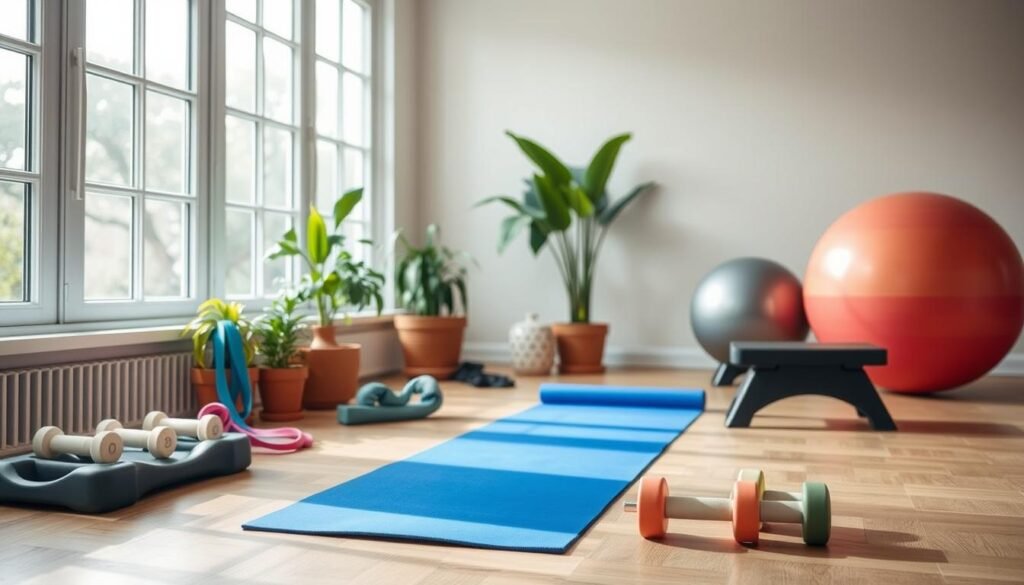
Adding equipment to low-impact workouts can make them more varied and challenging, making them more fun and effective17. With the right tools and a good fitness plan, you can reach your fitness goals and improve your health.
| Equipment | Benefits |
|---|---|
| Resistance Bands | Improved muscle strength, increased flexibility, enhanced joint stability |
| Stability Balls | Improved core strength, balance, posture |
Low-Impact Workouts for Seniors
As people get older, staying active is key. Low-impact workouts are great for seniors. They help with mobility, balance, and more18. These exercises can be changed to fit each person’s needs.
Recommended workouts include spinal stretches and squats with rotations18. They help with balance and muscle strength. It’s important to work out different muscle groups gently18.
Research shows many seniors can benefit from these workouts19. They help with joint and bone health. Tai chi, for example, can improve life for those with chronic pain19.
Seniors can see better joint health and lower injury risk with these workouts18. Always talk to a doctor before starting a new exercise plan, even more so for older adults19.
Low-Impact Cardio Options
Low-impact cardio is great for improving heart health without harming your joints20. It’s perfect for those trying to avoid heart disease and type 2 diabetes20. It’s also good for beginners or people with health issues, as it can be adjusted to fit any fitness level20.
Recommended exercises include walking, strength training, and tai chi20. These workouts target muscles like glutes, abductors, and hamstrings20. For more options, biking, swimming, and rowing are excellent, as they’re low-impact and effective21.
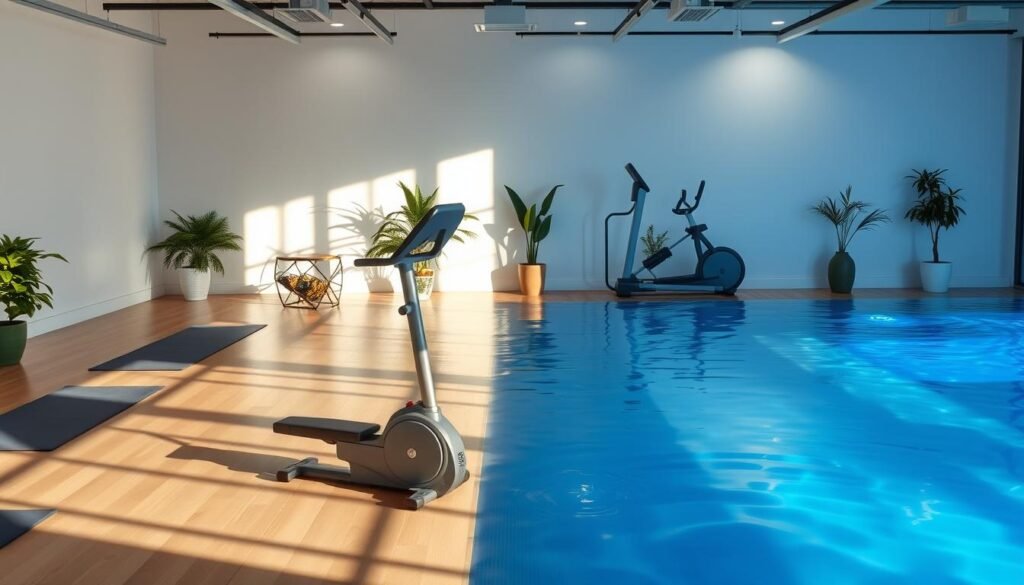
Adding strength training to your routine can also boost your heart health20. Mix up your workouts with exercises that work many muscles at once21. This way, you can keep your heart rate up and stay safe while exercising2021.
To learn more about low-impact cardio, check out low-impact cardio. It has tips on benefits and starting a low-impact workout.
Community Classes and Resources
Joining in on joint-friendly fitness routines is more fun with friends by your side. Places like Fitness Premier Clubs offer low-impact exercises like walking and yoga. They have a welcoming space with expert help and all the gear you need, open 24/7. You can learn more about these workouts on the Fitness Premier Clubs website.
Community classes and online tools make low-impact workouts more fun and motivating22. You can join walking groups or yoga classes at local spots. These are great for staying active and healthy.
Finding Local Low-Impact Classes
Looking for local classes? Just search online or ask at your gym. Community centers and health providers also offer classes. They’re perfect for keeping fit without putting too much strain on your joints.
Online Resources and Apps
Online, you’ll find many tools to help with low-impact workouts. Apps like MyFitnessPal offer workout plans and tracking. Online forums are also great for staying motivated and connected with others22.
The Role of Nutrition
Proper nutrition is key for low-impact workouts. It gives you the energy and nutrients you need to perform well and recover fast23. Eating foods full of antioxidants, like dark greens and berries, helps lessen muscle damage and inflammation from working out23.
Nutrition is also vital for easy-on-the-joints exercises. It helps keep your joints healthy and lowers injury risk. For exercises like yoga or swimming, a diet rich in omega-3s from foods like salmon and walnuts is best. This reduces inflammation and supports joint health24.
Here are some tips for better nutrition for low-impact workouts:
- Eat a balanced diet with fruits, veggies, whole grains, and lean proteins
- Drink lots of water before, during, and after working out23
- Stay away from sugary and processed foods that can cause inflammation and slow recovery25
By following these tips and eating well, you can improve your nutrition. This supports your health and fitness goals24.
| Nutrient | Food Sources | Benefits |
|---|---|---|
| Antioxidants | Dark green leafy vegetables, berries | Reduce muscle damage and inflammation |
| Omega-3 fatty acids | Salmon, walnuts | Reduce inflammation and promote joint health |
Staying Motivated
Staying motivated is key to keeping up with workouts. Joining a workout group or finding a workout buddy can help a lot26. Activities like walking or cycling are great because they’re fun and can be done with others27. Yoga or Pilates can also keep you motivated by making you feel accomplished and relaxed28.
Tracking your progress is important too. Use a fitness tracker or journal to see how far you’ve come and set goals26. Doing bodyweight exercises or resistance band workouts at home or with friends can keep you motivated27. Mixing up your workouts and tracking your progress helps you stay on track and reach your fitness goals.
For more tips on low-impact workouts and staying motivated, check out healthyshopperplacer.com. They have lots of resources and advice for a healthy lifestyle. By trying different low-impact workouts and tracking your progress, you can stay motivated and reach your fitness goals28.
Safety Considerations
When you’re doing joint-friendly workouts, safety is key to avoid injuries. Gentle and low-impact routines are great, but listen to your body. If you feel pain, adjust the exercise to avoid discomfort29.
Overuse injuries can happen from too much repetition in workouts. These injuries cause small damages that don’t heal30.
A good fitness plan includes cardio, strength training, and stretching30. Make sure to move fully in each strength training rep to avoid muscle imbalances and injuries. Drinking water is also important: have a pint 15 minutes before and after exercising30.
Cool down for at least 10 minutes after working out. This helps prevent soreness and injury30.
Here are some tips for a safe workout:
- Change your workout shoes every 300 to 500 miles or 6 to 8 months30
- Use RICE (rest, ice, compression, elevation) for muscle injuries30
- Avoid too much intensity and the wrong gear to lower injury risk29
By following these tips and choosing joint-friendly routines, you can reduce injury risk. This way, you’ll have a safe and effective workout29.
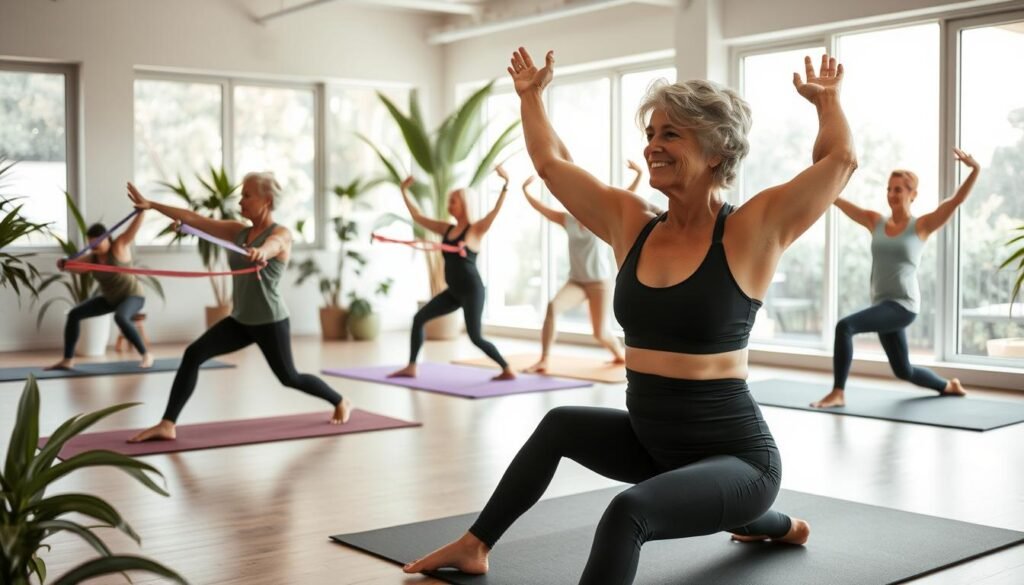
Low-Impact Workout Myths
Many think low-impact workouts don’t burn calories or improve fitness. But, this myth is not true. Low-impact workouts can be as tough and beneficial as high-impact ones. They help lower the risk of heart disease, diabetes, and some cancers31. A study by the University of Bath shows they burn as many calories as high-impact ones31.
Some believe you can spot-reduce fat in certain areas. But, this is a myth. Doing strength training two to three times a week protects muscle and offers health benefits32. Low-impact exercises like Pilates strengthen bones and muscles without the high-impact31. Yoga or swimming can be adjusted for any fitness level.
It’s key to know the truth about low-impact workouts. They are great for improving health and wellness without harming joints.
Debunking Common Misunderstandings
- Low-impact workouts can be effective for burning calories and improving overall fitness.
- Spot reduction of fat in specific body areas is not possible.
- Strength-training workouts can help protect muscle mass and lead to multiple health benefits.
Adding easy-on-the-joints workouts to your routine can bring many benefits. It’s time to clear up the myths about low-impact workouts and see their real value.
The Long-Term Benefits of Low-Impact Workouts
Low-impact cardio and workouts with minimal impact can greatly improve your health and fitness33. They also help in building muscle and strengthening bones33. These exercises are good for your joints, like the knee, and can prevent injuries34.
Some key benefits of low-impact workouts include:
- Improved joint health
- Enhanced flexibility and balance
- Reduced risk of injury
- Increased muscle mass and bone strength
Low-impact workouts are great because you can do them every day35. They’re perfect for those with tight schedules35. Plus, they’re great for working out at home because they don’t need much space35.
To learn more about low-impact workouts and their benefits, check out healthyshopperplacer.com. They talk about why adding low-impact cardio and strength training to your routine is important33
Integrating Low-Impact Workouts into Daily Life
Finding ways to move and staying active is key to adding low-impact workouts to your day36. Try walking or swimming to keep your joints happy. Yoga or Pilates can also be tailored to fit your fitness level and goals.
Low-impact exercises are great for those who want to ease joint pressure and avoid injuries37. They’re perfect for all fitness levels, even beginners or those with health concerns. Adding these exercises to your routine can boost your health and mood36.
Here are some tips to keep up with low-impact workouts:
- Begin with short, easy sessions and slowly add more time and intensity
- Work out with a friend or join a class to stay motivated
- Make low-impact exercises a part of your daily life, like taking the stairs
By making low-impact workouts a daily habit, you’ll enjoy many benefits. These include better heart health, more flexibility, and a happier mind36. Always listen to your body and talk to a doctor before starting any new exercise37.
| Low-Impact Workout | Benefits |
|---|---|
| Walking | Improves cardiovascular health, reduces joint pressure |
| Swimming | Enhances flexibility, builds muscular strength |
| Yoga | Improves balance, reduces stress and anxiety |
Conclusion: Embracing Low-Impact Workouts
Starting your fitness journey with low-impact workouts is a smart choice38. These exercises are gentle and help you stay healthy without hurting your body. They improve your flexibility, range of motion38, and heart health38 without putting too much strain on you.
Adding activities like walking, cycling, and weightlifting to your routine is beneficial39. They boost your bone density, muscle strength39, balance, and help reduce stress39. By choosing exercises that fit your age, fitness level, and needs, you can get the most out of39 low-impact workouts.
Starting your journey to a healthier lifestyle is easy. Look into the many low-impact options out there. Find the ones that you enjoy and stick with them. With regular practice and a positive attitude, you can change your body and mind for the better, one workout at a time.
FAQ
What are low-impact workout routines?
Who can benefit from low-impact workouts?
What are the common types of low-impact workouts?
What are some popular low-impact workout routines?
How can I design my own low-impact workout routine?
Why are warm-up and cool-down important for low-impact workouts?
How can equipment enhance low-impact workouts?
What are the benefits of low-impact workouts for seniors?
What are some low-impact cardio options?
How can I find low-impact workout classes and resources?
How does nutrition support low-impact workouts?
What strategies can I use to stay motivated with low-impact workouts?
How can I ensure safety during low-impact workouts?
What are common myths about low-impact workouts?
What are the long-term benefits of incorporating low-impact workouts?
How can I integrate low-impact workouts into my daily routine?
Source Links
- What Are the 12 Best Low-Impact Exercises?
- 5 Low Impact Cardio Exercises That Protect Your Joints
- What Is Low-Impact Exercise? | Cigna Healthcare
- Low-Impact Workouts: What They Are, Health Benefits, and Getting Started
- Your Complete Guide to Low-Impact Workouts
- Stay active with 6 low-impact workouts
- Looking for a Minimal Stress Workout? Try Low-Impact Exercise
- 10 Types of Low Impact Cardio That Come With Major Health Benefits
- The 9 Best Low Impact Workouts That Still Burn Major Calories
- 40-Minute Low Impact Workout (Video) | Nourish Move Love
- 2-Week Low-Impact Workout Challenge | Well+Good
- How To Build Your Own Workout Routine (Plans & Exercises)
- 5 steps to start a fitness program
- Warm Up, Cool Down
- The right way to warm up and cool down
- Your Guide to Low Impact Strength Training Exercises
- Your Guide to Low Impact Strength Training | Method Gym
- Low-Impact Exercises for Older Adults
- 8 Low-Impact Workouts and Exercises for Seniors – SilverSneakers
- How To Do a Low-Impact Cardio Workout at Home
- This Low-Impact Cardio Workout Will Actually Get Your Heart Rate Up
- Exercise Programs That Promote Senior Fitness
- Nutrition’s Role in Physical Fitness
- Integrated Role of Nutrition and Physical Activity for Lifelong Health
- Role of Physical Activity for Weight Loss and Weight Maintenance
- Five Low Impact Exercises to Stay Healthy | Benenden Health
- The Best The Best Low-Impact Exercises for SeniorsThe Best
- 7 Benefits of Low-Impact Workouts—And Why Fitness Pros Love Them
- 5 tips for exercise safety
- Safe Exercise – OrthoInfo – AAOS
- 4 Myths About Low-Impact Workouts and the Truths You Should Know
- 4 Common Exercise Myths, Debunked – SilverSneakers
- 7 Benefits of Low-Impact Workouts—And Why Fitness Pros Love Them
- 5 Benefits of Low-Impact Exercise | Grady Health
- 8 Benefits of Low-Impact Workouts | Inclusive Movement
- Using the Idea of “Cozy Cardio” to Embrace Low-Impact Exercises
- The Advantages of Low Impact Workouts | FS8
- Embrace Movement: A Low-Impact Workout for Active Lifestyles
- A Gentle Path to Wellness – BioKissed



